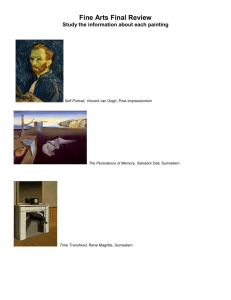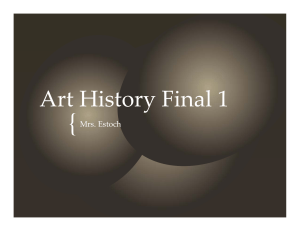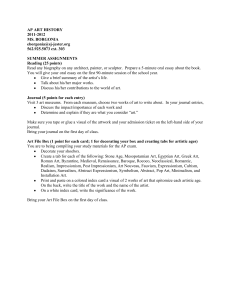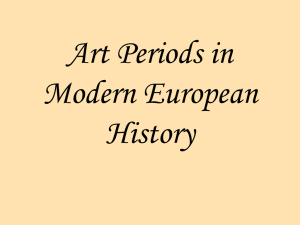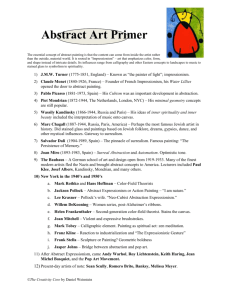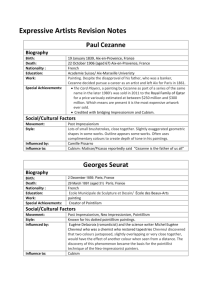powerpoint_Movements_in_Art_History
advertisement
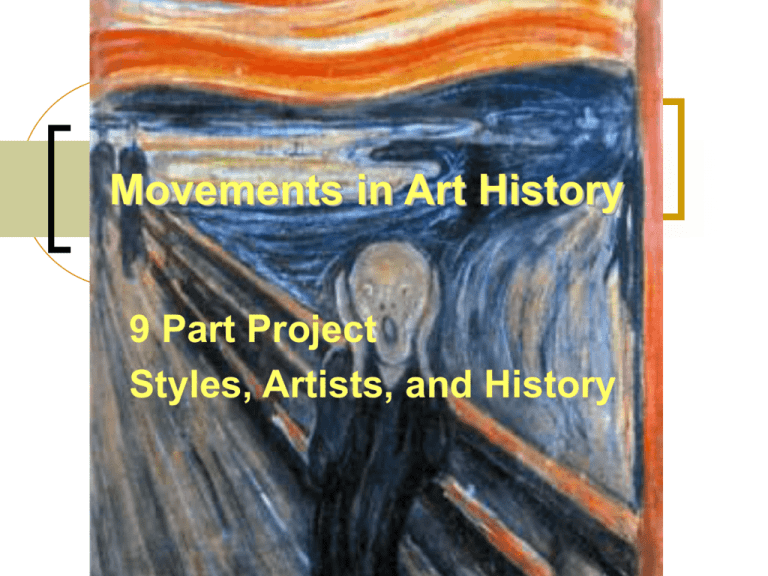
Movements in Art History 9 Part Project Styles, Artists, and History REALISM & the Renaissance WHEN?? The Renaissance was between 1400 A.D. to 1600 A.D. WHERE?? It began in Italy. WHAT WAS IT? Renaissance means “Rebirth” Paint things as they appear in life, realistically. A more accurate representation of the human body, and mathematical perspective. WHAT DID IT LOOK LIKE? Photograph-like realism. SUBJECT MATTER: Christian themes, ancient mythology, and nature scenes. WHO?? Artists included Leonardo Da Vinci, Michelangelo, Raphael, and Donetello The most praiseworthy form of painting is the one that most resembles what it imitates. -- Leonardo da Vinci ”The Mona Lisa” Leonardo Da Vinci "Leonardo, of Vinci“ Superb level of Realism Both artist and scientist Dissected human bodies for his study of human body. Most famous painting was “The Mona Lisa,” 1505. Famous for her mysterious identity and smile At the Louvre Museum in Paris, France. Michelangelo Buonarroti “The Creation of Adam” On the ceiling of the Sistine Chapel in Rome, Italy Michelangelo’s painting illustrates the Book of Genesis from the Old Testament Bible. Worked alone Painted lying on his back on scaffolding. Michelangelo took over four years to paint over 6000 square feet. “The Creation of Adam” By MICHELANGELO REALISM “The Last Supper” by Leonardo Da Vinci Impressionism WHERE? Started in France WHEN? during the late 19th and early 20th centuries. WHAT WAS IT? Catch the impression of the moment. Show the effects of light on a subject (this was more important than exact depiction of form) -Impressionism in painting arose out of dissatisfaction with the classical subjects and precise techniques of paintings. Impression, Sunrise 1872 by Claude Monet "Impressionist“- A term applied by a reporter who said that Monet’s sketchy landscape ‘Sunrise’ reminded him of wallpaper. WHAT DID IT LOOK LIKE? -Unmixed light colors -Small quick brush strokes -Scenes from Everyday Life WHO WERE ARTISTS? Monet, Degas, Renoir, Seurat, Cassatt,… Claude Monet “The Rouen Cathedral” Monet often painted the same subject over and over again to observe the changing light. He painted the Rouen Cathedral over 40 times. The true subject is LIGHT. “The Rouen Cathedral” by Claude Monet “The Rouen Cathedral” by Claude Monet Claude Monet IMPRESSIONISM Pierre Auguste Renoir Modern people enjoying their leisure time in outdoor or cultural events. Impressionist aesthetic – Renoir was interested in the changing moment. Pierre Auguste Renoir IMPRESSIONISM Edgar Degas Degas=Dancers The female ballet dancer became his favorite theme. Edgar Degas IMPRESSIONISM Georges Seurat Invented a technique known as pointillism: painting with small dots of color “A Sunday Afternoon on the Island of La Grande Jatte” “A Sunday Afternoon…” by Georges Seurat Georges Seurat IMPRESSIONISM Mary Cassatt American Worked in Paris with friend, Degas who introduced her to the Impressionists Mother and Child theme Mary Cassatt IMPRESSIONISM Post Impressionism Vincent Van Gogh WHEN? 1880's to 1900 WHAT WAS IT? an extension of Impressionism and a rejection of that style's inherent limitations. They wanted to add emotion and symbolic meaning to their art. WHAT DID IT LOOK LIKE? Similar pure, brilliant colors and swift brushstrokes of broken color like Impressionism and the freedom from traditional subject matter But more expressive. Artworks often contain bold, unrealistic colors and expressive brushstrokes. WHO? Vincent Van Gogh Vincent Van Gogh Dutch (born in Netherlands) -At age 27 became an artist Van Gogh’s artistic career lasted only 10 years Made about 750 paintings and 1600 drawings. Sold only one painting during his lifetime. The Red Vineyard. Vincent Van Gogh Suffered bouts of insanity -Cut off his own ear. He committed himself to an asylum, a mental institution. During his stay he painted Starry Night -Close relationship to brother, Theo. Hundreds of letters to Théo are a record of Van Gogh’s life. Starry Night / 1889 -Emotional spontaneity in painting -Huge influence on Expressionism At the age of 37, he died from a self-inflicted gunshot wound in 1890. “Starry Night” by VINCENT VAN GOGH Vincent Van Gogh POST IMPRESSIONISM Vincent Van Gogh POST IMPRESSIONISM Expressionism (in Norway) WHERE? Norway WHEN? 1890s WHO? Edvard Munch WHAT: themes as misery, sickness, insanity, women, and death “Leonardo dissected the body; I dissect the soul.” Edvard Munch “The Scream” is an example of Munch's "soul paintings." Expresses conflict: lines, colors, facial expression “The Scream” 1893 “Could only have been painted by a madman.” “The Scream” by EDVARD MUNCH Edvard Munch Painting focuses on the changing nature of woman as she matures from innocence into full “The Dance of Life” 1900 sexuality, and then to old age an innocent woman, virginal in white, Munch developed these great themes of mature, sober figure in black Angst, Love, Sex and Death “The Dance of Life” by EDVARD MUNCH Edvard Munch Edvard Munch EXPRESSIONISM German Expressionism WHERE? Germany WHEN? Began in WWI into WWII, 1910 to 1940's WHAT WAS IT? -Purpose to express the inner state of the artist (which the Nazi gov’t could not tolerate). -Hitler applied to the Bauhaus art school and was rejected. -In 1933 the Bauhaus school was closed by the Nazi gov’t. -Expressionist art was attacked and artists’ work was confiscated and art schools were closed. -Hitler's art preference was the realism and conventional forms, subjects like heroic soldiers Adolph Hitler, outraged by antiGerman Expressionists embarked upon his own crusade to rid Germany of all the "degenerate" art within his Reich. -Hitler opened a dual exhibition One exhibit of Nazi approved art called the Great German Art and another exhibition of “Degenerate” Art -Over three million visitors made it the largest attended exhibition. German Expressionism WHAT DID IT LOOK LIKE? -Inspired by emotional works of Vincent Van Gogh and Edvard Munch -Distorted forms violent colors and exaggerated lines -Depiction of the artist's mental state of being and intense emotional expression. -Call upon personal experiences to illustrate the negative aspects of German life and war. WHO? Franz Marc, Georges Roualt Franz Marc Specializes in Animals. Art career was cut shortKilled in war. I am trying to intensify my feeling for the organic rhythm of all things, to achieve empathy with the throbbing and flowing of nature's bloodstream in trees, in animals, in the air. - Franz Marc Franz Marc EXPRESSIONISM Georges Rouault Georges Rouault began his artistic career as an apprentice to a stained glass designer. His themes were of religious subjects Hard, thick brushstrokes and dark outlines that resembled stained glass. Violent colors Georges Rouault EXPRESSIONISM PABLO PICASSO Spainish painter and sculptor Considered the greatest artist of the 20th century By the age of 15 he was already technically skilled in drawing and painting. Every child is an artist. The problem is how to remain an artist once he grows up. Pablo Picasso There are painters who transform the sun to a yellow spot, but there are others who with the help of their art and their intelligence, transform a yellow spot into the sun. Pablo Picasso EARLY WORKS of PICASSO Picasso’s Blue and Rose Periods Blue Period (1901-04) Triggered by a close friend's suicide. Expressing human misery, sadness and alienation. Various shades of blue dominated his work. Rose Period (1904-05) Paintings took on a warmer more optimistic mood. He changed his palette to pinks and reds. He is believed to have fallen in love at this time. Subjects were drawn from the circus. Picasso- BLUE PERIOD ROSE PERIOD -Picasso Analytic Cubism Picasso Monochromatic earth tones Fragmented, broken window appearance Sought to totally flatten space Systematic study of structure Represent an object as if it’s viewed from several angles or at different moments in time. ANALYTIC CUBISM -Picasso Synthetic Cubism Picasso “Guernica” mural Portrayal of the horrors of war. Bombing of the town of Guernica during the Spanish civil war. Monochromatic palette in an attempt to suggest the bleakness of the tragedy. Symbolic depiction -the bull, the dying horse, a fallen warrior, a mother and dead child, a woman trapped in a burning building, another rushing into the scene, and a figure leaning from a window and holding out a lamp. Flat, bright decorative patterns Childlike, not many details Abstract Show front and side view “Guernica” SYNTHETIC CUBISM Picasso Pablo Picasso SYNTHETIC CUBISM Pablo Picasso Georgia O'Keeffe was born in Wisconsin. Enlarged subjects Painter of FLOWERS, landscapes, and bones Female sexuality Abstract and the representational. Went to New Mexico and painted landscapes and cow skulls and bones. She was considered the premier female artist of the 20th century, a title she considered sexist. Georgia O’Keeffe ABSTRACT ART Georgia O’Keeffe ABSTRACT ART Georgia O’Keeffe ABSTRACT ART Surrealism Expression of the unconscious “Surreal” means “beyond reality". SALVADOR DALI Spanish painter, writer, and member of the surrealist movement. Bizarre, dreamlike images, wild and hallucinatory states. Realistic detail influenced by the Renaissance masters. Eye-fooling; dual images Melting things with crutches Ants represent decay Dream imagery and everyday objects in unexpected forms, such as the famous limp watches in The Persistence of Memory. Here time must lose all meaning. This painting is a symbol of the Surrealist movement. Salvador Dali “The Persistence of Memory” Salvador Dali SURREALISM Salvador Dali SURREALISM Salvador Dali SURREALISM Salvador Dali SURREALISM Surrealism Frida Kahlo Born: 6 July 1907 In Mexico City, Mexico Serious bus accident She began painting shortly after the accident because she was bored in bed. This became her lifelong profession. Married Mexican Muralist, Diego Rivera Had miscarriages, and she was never to have children. Frida and Diego both had affairs. Had tremendous pain and fatigue all throughout her life Her last words in her diary read "I hope the leaving is joyful and I hope never to return". Frida Kahlo Best Known As: Mexico's most famous woman artist Frida used her life as the theme for her self-portraits. serious bus accident Painting thus became the medicine for her physical and emotional pain. Painted symbolically to express and understand the tragedy of her life. "I suffered two grave accidents in my life. One in which a streetcar knocked me down.....The other accident is Diego." She painted her anger and hurt over her stormy marriage, the painful miscarriages, and the physical suffering she underwent because of the accident. Labeled Surrealist. Her paintings freed the unconscious from repression, dreams, desires and thoughts. 'They thought I was a Surrealist,' she said, 'but I wasn't. I never painted dreams. I painted my own reality.' Frida Kahlo Frida Kahlo POP ART 1950's to 1960's Origins in England in the 1950s and made its way to the United States during the 1960s. Images of the popular culture such as billboards, comic strips, magazine advertisements, celebrity photographs, and supermarket products. Bring art closer to real life. Put popular culture into their art in the same way popular culture flooded into people's subconscious. Pop artists wanted to bring art back to the people and to make it more meaningful to everyday folks. Critics saw Pop art as vulgar, sensational and without merit. Supporters liked it because they felt it was an art everybody could understand. ANDY WARHOL Soup cans and movie stars Favorite printmaking technique was silkscreen He was shot and nearly died. 20 years later, he died from complications after a gall bladder operation. “In the future everyone will be famous for fifteen minutes.” Best Known As: The Campbell's Soup can artist Andy Warhol POP ART Andy Warhol POP ART Roy Lichtenstein Characters from comic-strips Ben-Day dots, lettering and speech balloons Comic book artists didn’t like that he copied their work. He wanted his works of art look machine made. Master of the stereotype. Characterized as ironic, humorous and witty. Roy Lichtenstein POP ART Keith Haring Born in Pennsylvania Cheerful, bold Lines, cartoon-like figures, lines of movement Vibrant, intense colors. Hearts, babies, dogs,…simple characters. Found his ‘canvases’ on the streets, subways Trademark “Radiant Baby” Concepts of birth, death, love, sex, war, drugs... Social messages like “Crack is Whack” Devoted his career to creating a truly public art. Died of AIDS in 1990 at the age of 32. Keith Haring POP ART Keith Haring POP ART Radiant Baby
